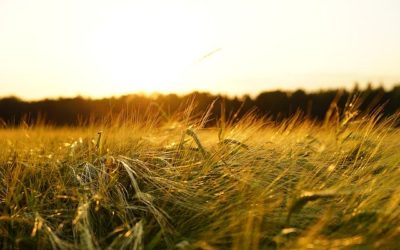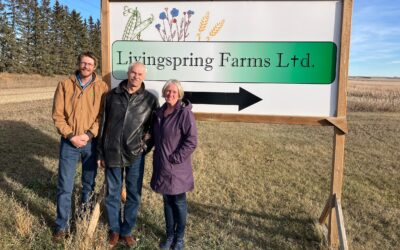The following piece is from our sister publication, Germination.
In the ever-evolving landscape of agriculture, innovation and diversity are key factors in ensuring a sustainable and thriving future. Enter the Diverse Field Crops Cluster (DFCC), poised to reshape the agricultural horizon by nurturing the growth and potential of a unique set of crops: flax, carinata, camelina, canaryseed, sunflower, hemp, quinoa, and mustard.
At its core, DFCC is a collaborative endeavour driven to propel the research and development of high-potential specialty crops. Spearheaded by Ag-West Bio, a leading bioscience industry association, this initiative has garnered substantial backing from Agriculture and Agri-Food Canada’s Canadian Agricultural Partnership Program, alongside committed contributions from industry partners. This collective support is a testament to the significance of DFCC’s goals and the potential it envisions.
The DFCC is committed to bringing together diverse industry stakeholders and research experts. By aligning these forces, the cluster seeks to seize untapped market opportunities and expedite the expansion of both cultivation areas and market returns for these unique crops.
“This project has been more than just a research initiative; it’s been about raising awareness about the importance of diversified agriculture and supporting these underrepresented crops,” says Carol Ann Patterson, project manager for the DFCC.
“As a food scientist by training, I’ve been able to contribute insights from the value-added perspective, considering how these crops can be incorporated into the food industry and beyond.”
Camelina
Over the past few years, the cultivation of camelina, an oilseed crop, has gained steady momentum. One particularly promising avenue for camelina’s growth is its potential use in producing biodiesel and jet fuel, similar to carinata. Camelina has been approved by Health Canada for human consumption purposes, albeit in a limited and specialized market.
The crop’s versatility shines in its adaptability to different rotations, notes Deb Puttick, oilseeds research team leader and biotechnology specialist at Smart Earth Camelina in Saskatoon, Sask. Camelina finds a comfortable place following wheat, barley, peas, lentils, and other cereal crops.
Mustard
Canadian farmers play a vital role in global mustard production, contributing nearly half of the world’s mustard crop. They also hold the distinction of being the top exporters of condiment mustards, encompassing brown, yellow, and oriental varieties. Much of this mustard is cultivated on the Prairies.
Taking charge of mustard seed commercialization is Mustard 21 Canada. This organization oversees the aspects related to bringing mustard seed to market. Despite the impressive production figures, CEO Rick Mitzel highlights a lag in crop development research within the mustard sector. To address this gap, the DFCC has proven invaluable. An ideal rotation would be one in which mustard crops follow a cereal crop.
Flax
Canadian flaxseed’s exceptional oil quality and higher oil content have positioned Canada as a leader in its global production and export. The University of Saskatchewan’s Crop Development Centre Flax Breeding Program, established in 1976, stands as the sole source of new flax cultivars for the Prairies, emphasizing its vital role in shaping the crop’s trajectory.
The program’s overarching objective — led by CDC flax breeder Bunyamin Tar’an — is the creation of advanced brown and yellow seed varieties with improved agronomic traits, addressing the needs of growers. The resulting higher quality, more productive lines with enhanced disease resistance hold the potential to reduce fungicide use, translating into cost savings for farmers while also delivering environmental benefits.
Hemp
A recent research initiative enabled by DFCC and led by Jan Slaski from InnoTech Alberta delved into the potential cadmium accumulation in Canadian hemp. Hemp, similar to flax and durum wheat, has the capacity to accumulate cadmium, a heavy metal. The research aimed to ascertain whether this accumulation could raise safety concerns and trade barriers. Cadmium accumulation wasn’t a significant issue in the fields studied.
This has big advantages. Consumers gain assurance in the safety of hemp grain products and farmers are relieved of cadmium-related concerns, while international communities receive solid proof of Canadian-produced hemp’s heavy metal contamination-free status. It’s a noteworthy testament to hemp’s suitability as a rotation crop, the researchers said.
Canaryseed
The journey towards establishing canary seeds as a significant player in the human food market is a complex process marked by both opportunities and challenges.
While there are pathways for processing and utilization, breaking into the mainstream consumer market is proving a challenge, notes Kevin Hursh, executive director of the Canary Seed Development Commission of Saskatchewan.
Its suitability as a rotation crop is also getting noticed.
“In looking ahead, I believe that canaryseed will assume greater significance due to the challenges we’re encountering with other crops. This underscores the need to not overlook or underestimate the potential of these lesser-known crops, especially in regions where they hold considerable value,” Hursh says.
He thinks back to when producers tackled the wheat midge issue, and a similar situation emerged in certain pockets of Saskatchewan. Devastated crops led to canaryseed emerging as a crucial alternative in that region, bridging the gap until farmers gained control over the situation.
Quinoa
Thanks to the support from DFCC, advancements have been made in developing earlier maturing, higher quality, and higher yielding quinoa varieties. This research has not only improved quinoa characteristics but has also identified various market opportunities and suitable varietals. Although relatively new among global cultivated crops, quinoa has gained momentum.
The research outcomes have been substantial. Maturity has been reduced from 160 to 95 days, protein content raised to over 18 per cent, and yields increased by 15 per cent. This uplifts nutritional standards, boosts returns for growers, and makes quinoa more marketable. This research has also reclassified quinoa as a cereal crop food, potentially increasing accessibility to pesticides for growers. Pesticide tolerance trials, herbicide, and disease-resistant trait incorporation, alongside screening, are currently ongoing by NorQuin, targeting commercial launch in 2023.
Quinoa is touted as a valuable addition to Western Canada’s crop rotations due to its high yield, late maturation, similar input costs, and immunity to key diseases seen in the region. The significance of research on minor crops like quinoa, supported by DFCC, is crucial in showcasing their benefits to growers and the industry amidst major commodity crops.
Sunflower
In recent years, Canada’s sunflower production, encompassing both oilseed and confection varieties, has declined due to a lack of innovation in sunflower genetics. The absence of modern hybrids adapted to northern growing conditions and equipped with necessary agronomic traits has limited growers’ options and international competitiveness, according to DFCC. However, research focusing on new sunflower varieties for confection, primarily used in the food market, is altering this landscape.
Related Articles
Why the Future is in Diverse Crops





